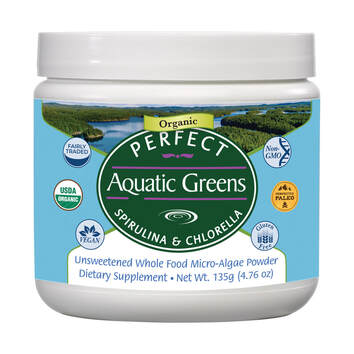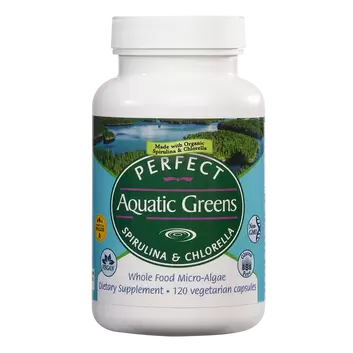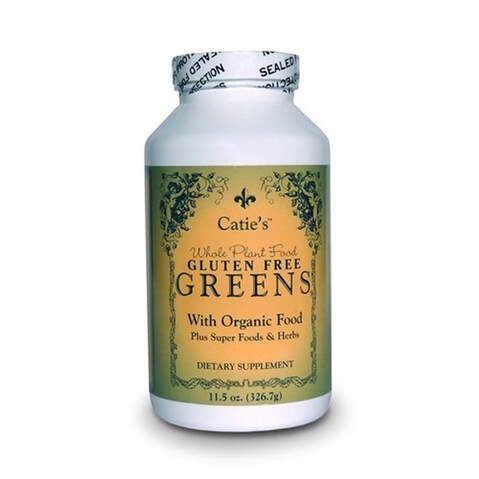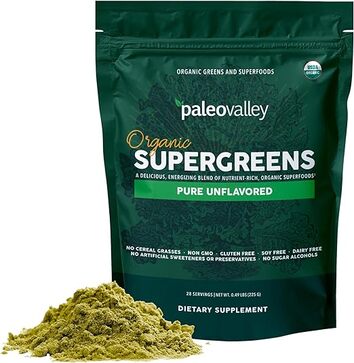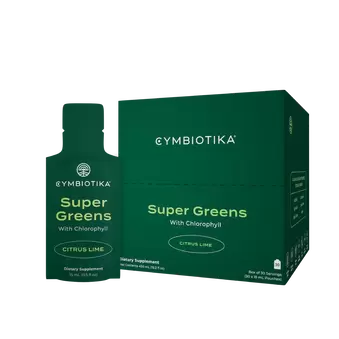Greens superfood powders have gained popularity as a convenient and nutrient-dense supplement that aims to provide a variety of health benefits. Here's a summary of the potential health benefits associated with super greens powders:
- Nutrient-Rich: Super greens powders typically contain a mix of nutrient-dense ingredients, such as spirulina, chlorella, kale, spinach, wheatgrass, and other green vegetables. These ingredients are rich in vitamins, minerals, antioxidants, and phytonutrients.
- Antioxidant Support: The high content of antioxidants in super greens powders may help combat oxidative stress and reduce the damage caused by free radicals in the body. Antioxidants play a crucial role in supporting overall health and may contribute to a lower risk of chronic diseases.
- Alkalizing Properties: Many super greens are alkaline-forming, which means they may help balance the body's pH levels. An alkaline environment is believed to support overall health and may counteract the acidity that can result from a diet high in processed foods and meat.
- Digestive Health: Some super greens powders contain ingredients with fiber and enzymes that support digestive health. Fiber can aid in regular bowel movements, while enzymes help break down nutrients for better absorption.
- Energy Boost: The combination of vitamins, minerals, and phytonutrients in super greens may contribute to increased energy levels. This can be especially beneficial for those who struggle with fatigue or need an energy boost during the day.
- Immune System Support: The immune-boosting properties of certain ingredients, such as spirulina and chlorella, may help enhance the body's natural defenses against infections and illnesses.
- Detoxification: Some super greens, like chlorella, are believed to support the body's detoxification processes by helping eliminate toxins and heavy metals. This may contribute to overall cellular health.
- Heart Health: The antioxidants, fiber, and plant compounds found in super greens powders may contribute to cardiovascular health by supporting healthy blood pressure and cholesterol levels.
- Weight Management: The nutrient density and fiber content of super greens may contribute to a feeling of fullness, potentially aiding in weight management by reducing overall calorie intake.
- Convenience: Super greens powders offer a convenient way to increase your intake of nutrient-rich greens, especially for those who have difficulty consuming enough vegetables through whole foods.
Common superfood ingredients
Green superfood powders typically contain a mix of nutrient-dense ingredients, each chosen for its unique health benefits. While formulations can vary between brands, here are some common ingredients you might find in green superfood powders:
- Spirulina: A blue-green algae rich in protein, vitamins, minerals, and antioxidants. It's known for its potential immune-boosting and anti-inflammatory properties.
- Chlorella: Another type of algae, chlorella is high in chlorophyll, vitamins, minerals, and protein. It's often included for detoxification support and may aid in digestive health.
- Wheatgrass: Derived from young wheat plants, wheatgrass is a source of chlorophyll, vitamins, minerals, and antioxidants. It's believed to have alkalizing properties.
- Barley Grass: Like wheatgrass, barley grass is rich in nutrients, including vitamins, minerals, and antioxidants. It's often included for its potential benefits to the immune system and overall health.
- Spinach: A nutrient-dense leafy green that provides vitamins, minerals, and antioxidants. It's known for its potential cardiovascular and anti-inflammatory benefits.
- Kale: High in vitamins A, C, and K, as well as minerals like calcium and potassium. Kale is a nutrient powerhouse known for its antioxidant properties.
- Alfalfa: Often included for its potential benefits to digestion and as a source of vitamins and minerals.
- Broccoli: Contains a variety of nutrients, including fiber, vitamins, and minerals. Broccoli is known for its potential anti-cancer properties and support for overall health.
- Acerola Cherry Extract: A natural source of vitamin C, which is essential for immune function and skin health.
- Beetroot: Rich in antioxidants, vitamins, and minerals, beetroot is often included for its potential benefits to cardiovascular health and exercise performance.
- Pineapple: Contains enzymes like bromelain, which may aid in digestion. Pineapple is also a source of vitamins and minerals.
- Probiotics: Some green superfood powders include probiotics to support gut health and digestion.
- Digestive Enzymes: Enzymes such as amylase, protease, and lipase are sometimes added to enhance digestion and nutrient absorption.
Spirulina
Spirulina is a type of blue-green algae that has been studied for its various health benefits which are attributed to its rich nutritional profile and unique bioactive compounds. Here are several key factors contribute to the positive effects observed:
- Nutrient-Rich Superfood: Spirulina is a rich source of essential nutrients, including protein, vitamins (especially B vitamins), minerals (iron and magnesium), and antioxidants. Its nutrient density makes it a valuable addition to the diet, especially for those with nutrient deficiencies.
- Antioxidant Properties: Spirulina contains various antioxidants, including phycocyanin, which gives it its blue-green color. Antioxidants help combat oxidative stress, potentially reducing the risk of chronic diseases and supporting overall cellular health.
- Anti-Inflammatory Effects: Phycocyanin, the unique pigment in spirulina, has been studied for its anti-inflammatory properties. Inflammation is linked to various chronic diseases, and reducing inflammation may contribute to better health.
- Cholesterol Regulation: Some studies suggest that spirulina may have a positive impact on lipid profiles, helping to lower total cholesterol and triglycerides while increasing "good" HDL cholesterol. This could be beneficial for heart health.
- Blood Pressure Management: Research indicates that spirulina may have a modest effect in reducing blood pressure, potentially benefiting those with hypertension. The mechanisms are not fully understood and require further investigation.
- Allergy Relief: Spirulina may have anti-allergic properties and could help alleviate symptoms of allergic rhinitis (hay fever). Some studies suggest a potential reduction in nasal congestion and itching.
- Blood Sugar Control: There is evidence to suggest that spirulina may have a positive impact on blood sugar levels, making it potentially beneficial for individuals with diabetes or those at risk of developing insulin resistance.
- Muscle Endurance and Exercise Performance: Some studies suggest that spirulina supplementation may enhance endurance and reduce muscle fatigue during exercise. Athletes and those engaged in physical activities may benefit from improved performance.
- Detoxification Support: Spirulina has been studied for its potential role in detoxifying the body by binding to heavy metals and aiding in their removal. This may have implications for individuals exposed to environmental toxins.
- Support for Anemia: Spirulina is a good source of bioavailable iron, which may be helpful for individuals with iron-deficiency anemia. The iron in spirulina is easily absorbed by the body.
chLorella
Chlorella is a type of freshwater algae that is often consumed as a dietary supplement due to its rich nutrient content. While individual responses to supplements can vary, chlorella is associated with several potential health benefits. Here are some positive health effects attributed to the consumption of chlorella:
- Nutrient Density: Chlorella is a nutrient-dense food, containing a wide range of essential nutrients such as vitamins, minerals, protein, and chlorophyll. It provides a concentrated source of nutrients that can contribute to overall health and well-being.
- Protein Content: Chlorella is a good source of protein, and it contains all essential amino acids. This makes it a valuable dietary option, especially for individuals following vegetarian or vegan diets.
- Vitamins and Minerals: Chlorella is rich in various vitamins (including B vitamins and vitamin C) and minerals (such as iron and magnesium). These nutrients play crucial roles in supporting energy metabolism, immune function, and overall health.
- Antioxidant Properties: Chlorella contains antioxidants, including chlorophyll, lutein, and beta-carotene, which help neutralize free radicals in the body. Antioxidants contribute to cellular health and may have anti-aging effects.
- Detoxification Support: Chlorella has been suggested to aid in detoxification by binding to heavy metals and toxins in the body, facilitating their excretion. This potential detoxifying effect is attributed to substances like chlorophyll and chlorella growth factor (CGF).
- Immune System Support: Some studies suggest that chlorella may enhance the activity of certain immune cells, contributing to a strengthened immune response. This immunomodulatory effect may help the body defend against infections.
- Gut Health: Chlorella contains dietary fiber, which can support digestive health by promoting regular bowel movements and supporting a healthy gut microbiota. A healthy gut is crucial for nutrient absorption and overall well-being.
- Cholesterol Management: Some research indicates that chlorella supplementation may have a positive impact on cholesterol levels. It may help lower total cholesterol and improve the ratio of HDL (good) to LDL (bad) cholesterol.
- Blood Sugar Regulation: Preliminary studies suggest that chlorella may have a beneficial effect on blood sugar levels. It may help regulate blood glucose, which is important for individuals managing diabetes or insulin resistance.
- Potential Anti-Inflammatory Effects: Chlorella has been studied for its anti-inflammatory properties, which may help reduce inflammation in the body. Chronic inflammation is associated with various health conditions, and managing it can contribute to overall well-being.
Spirulina + CHlorella
Concerns for grasses
Wheatgrass and barley grass are commonly included in green superfood powders, and while they are grasses and generally considered gluten-free, there can be concerns for individuals with gluten sensitivities or celiac disease. Here's why:
- Potential Cross-Contamination: Even though wheatgrass and barley grass themselves are gluten-free, there is a risk of cross-contamination during harvesting and processing. If the plants are grown in fields or processed in facilities that also handle wheat or other gluten-containing grains, there's a chance that gluten may be present in the final product.
- Sprouted vs. Unsprouted: Some individuals with gluten sensitivities or celiac disease may find that they react differently to sprouted versus unsprouted wheatgrass or barley grass. Sprouting is a process that can break down some of the proteins, potentially reducing the gluten content. However, this might not eliminate the risk of cross-contamination.
- Individual Sensitivity: People with gluten sensitivity or celiac disease react to specific proteins found in wheat, barley, and other gluten-containing grains. While wheatgrass and barley grass are harvested before the grain forms, some individuals may still be sensitive to the remaining proteins, even in small amounts.
- Check Labels: Look for products that explicitly state they are gluten-free and have undergone testing for gluten content.
- Choose Certified Products: Some products carry certifications like the "Certified Gluten-Free" label, which indicates that the product meets strict gluten-free standards.
- Consult Healthcare Professionals: If in doubt or if you have a known gluten sensitivity or celiac disease, it's advisable to consult with healthcare professionals or dietitians for personalized advice.
- Monitor Reactions: Pay attention to how your body responds to the consumption of wheatgrass or barley grass. If you experience any adverse reactions, it's essential to avoid these ingredients.
Wheat Germ Agglutin
Wheat germ agglutinin (WGA) is a lectin, which is a type of protein that can bind to carbohydrates. It is naturally found in wheat and other grains, with higher concentrations in the germ and bran of wheat. While lectins, including WGA, are part of many plant foods and are generally considered safe for most people, there has been some concern about potential health effects of WGA in certain circumstances.
Here are some aspects of WGA and its potential effects on health:
Here are some aspects of WGA and its potential effects on health:
- Binding to Carbohydrates: WGA has an affinity for binding to specific carbohydrates, particularly N-acetylglucosamine and sialic acid, which are components found on the surface of cells in the human body.
- Impact on Gut Health: Some studies suggest that WGA may have the ability to bind to the lining of the gut, potentially disrupting the integrity of the gut barrier. This has led to concerns that WGA might contribute to increased intestinal permeability, commonly known as "leaky gut." Increased intestinal permeability could theoretically allow substances to pass through the gut lining and enter the bloodstream, potentially triggering an immune response.
- Immune System Activation: In some studies, WGA has been shown to stimulate the immune system and may contribute to inflammation. However, the significance of these effects in the context of a normal diet is not well-established.
- Potential Impact on Autoimmune Conditions: Some proponents of certain dietary approaches, such as the Paleo diet, argue that lectins like WGA may play a role in autoimmune conditions. The idea is that lectins might mimic certain self-antigens and trigger an immune response against the body's tissues in susceptible individuals.
Grass-free supplements
Catie's Organic Gluten Free Greens is a super concentrated whole food formula; abundant in vitamins, minerals, healing phytonutrients, fiber, antioxidants, good probiotic bacteria, digestive enzymes, and essential fatty acids. One tablespoon of Catie's Organic Gluten Free Greens is equal to 7 daily servings of the most potent green vegetables. Catie's Organic Gluten Free Greens is rich in natural glutathione from one of nature's richest sources- asparagus. Catie's Greens is easily absorbed into the digestive system and can be mixed into any beverage.
Paleovalley offers a supergreens powder that contains absolutely no cereal grasses. Virtually every other greens or superfood powder on the market contains a heavy dose of cereal grasses such as wheatgrass, barley, oat, or rye. Unfortunately, because humans cannot properly digest grass, some liken buying a cereal grass heavy powder to flushing money down the drain.
As mentioned these grasses contain a lectin called WGA which is highly inflammatory. Certain experts believe that WGA may be as responsible for the health-damaging effects of wheat as gluten, and many who are gluten sensitive also have issues with WGA.
As mentioned these grasses contain a lectin called WGA which is highly inflammatory. Certain experts believe that WGA may be as responsible for the health-damaging effects of wheat as gluten, and many who are gluten sensitive also have issues with WGA.
Supplements to consider
Cymbiotika offers a refreshing product (considering the addition of broccoli seed and glucoraphanin powder) that contains the following active ingredients:
- Chlorophyll (Sodium Copper Chlorophyllin from Mulberry Leaf), Organic Alfalfa Powder, Organic Oat Grass, Organic Spinach Powder, Organic Spirulina, Organic Kale, Broccoli Seed Powder Extract, 13% Glucoraphanin Powder
The relationship between broccoli, cruciferous vegetables, glucoraphanin, and the NRF2 pathway is a fascinating aspect of how certain dietary compounds can interact with cellular processes to potentially promote health. Here's an overview of these components and their relationship:
Sulforaphane, derived from glucoraphanin in cruciferous vegetables like broccoli, is a known activator of the NRF2 pathway. Sulforaphane interacts with a specific protein, KEAP1, which normally inhibits NRF2. When sulforaphane binds to KEAP1, it allows NRF2 to move into the cell nucleus and activate the expression of antioxidant and detoxification genes.
The activation of the NRF2 pathway by sulforaphane results in the increased production of enzymes such as glutathione peroxidase, superoxide dismutase, and others. These enzymes play a crucial role in neutralizing reactive oxygen species (ROS) and supporting the body's defense against oxidative stress. Additionally, NRF2 activation enhances the cellular detoxification process.
The activation of the NRF2 pathway by sulforaphane is associated with various potential health benefits. These include protection against oxidative stress-related conditions, anti-inflammatory effects, and potential contributions to the prevention of chronic diseases such as cardiovascular disease and certain types of cancer. Including cruciferous vegetables like broccoli in a balanced diet is a recommended strategy for promoting overall health and well-being.
- Cruciferous Vegetables: Cruciferous vegetables belong to the Brassicaceae family and include broccoli, cauliflower, Brussels sprouts, kale, and cabbage, among others. These vegetables are rich in various bioactive compounds, including glucosinolates, which are sulfur-containing compounds.
- Glucoraphanin: Glucoraphanin is a type of glucosinolate found in cruciferous vegetables, particularly in high concentrations in broccoli. When these vegetables are chewed, chopped, or otherwise processed, an enzyme called myrosinase comes into contact with glucoraphanin, leading to the formation of sulforaphane.
- Sulforaphane: Sulforaphane is a bioactive compound formed from the breakdown of glucoraphanin. It is considered a potent antioxidant and is known for its potential health-promoting properties.
- NRF2 Pathway: The NRF2 (nuclear factor erythroid 2-related factor 2) pathway is a cellular signaling pathway that plays a crucial role in the regulation of antioxidant and detoxification responses. When cells experience oxidative stress or encounter harmful substances, NRF2 is activated, leading to the upregulation of genes involved in antioxidant defense, detoxification, and cell survival.
Sulforaphane, derived from glucoraphanin in cruciferous vegetables like broccoli, is a known activator of the NRF2 pathway. Sulforaphane interacts with a specific protein, KEAP1, which normally inhibits NRF2. When sulforaphane binds to KEAP1, it allows NRF2 to move into the cell nucleus and activate the expression of antioxidant and detoxification genes.
The activation of the NRF2 pathway by sulforaphane results in the increased production of enzymes such as glutathione peroxidase, superoxide dismutase, and others. These enzymes play a crucial role in neutralizing reactive oxygen species (ROS) and supporting the body's defense against oxidative stress. Additionally, NRF2 activation enhances the cellular detoxification process.
The activation of the NRF2 pathway by sulforaphane is associated with various potential health benefits. These include protection against oxidative stress-related conditions, anti-inflammatory effects, and potential contributions to the prevention of chronic diseases such as cardiovascular disease and certain types of cancer. Including cruciferous vegetables like broccoli in a balanced diet is a recommended strategy for promoting overall health and well-being.

